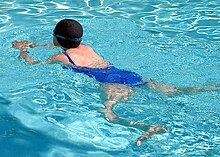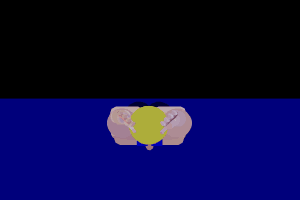Breaststroke
Breaststroke swimming is a type of swimming . It is mostly learned as the first technique in swimming courses in German-speaking and European countries. The technique has been known since the Stone Age . It was first systematically described in 1538 by Nikolaus Wynmann and again around 1815 by Ernst von Pfuel . The competition variant is the most difficult and the most time-consuming to learn swimming type. Due to the disposition of their hip joints, some swimmers can not perform a regular breaststroke technique with straddle strokes. In addition, the mutual coordination of the movements of arms and legs in competition breaststroke swimming is a lot more demanding than in all other types of swimming.
technology
The breaststroke technique is performed in such a way that the arms, lying together under water, are brought forward at the same time and then moved backwards through the water. In a more modern form, which is mainly used by high-performance athletes, the hands are moved forward over the water to reduce water resistance. During the subsequent movement backwards, the hands are placed slightly inwards. The optimal position of the palms and their position relative to the pelvis are called the feeling of water and are decisive for propulsion . The movement along the body axis relative to the body is quite small. By far the greatest momentum carried by the tensile and shear movement in opposition to the swimming direction. This movement is immediately followed by a straddle strike. The next arm stroke is then towards the end of the straddle stroke. In the so-called undulation technique (from the Latin unda - the wave), a wave movement of the body is carried out during the forward thrust, similar to swimming butterflies , and the arms are brought forward above the surface of the water. This creates additional propulsion. The regularity of this style variant was initially controversial, but is now seen as conforming to the rules.
Competition rules
The FINA competition rules state that the body must be kept completely in the chest position from the beginning of the first arm stroke after the start and after each turn. The shoulders must be parallel to the water surface. Rolling to the supine position is not permitted at any time. After the start and after each turn, the swimmer is allowed to perform a so-called diving pull before returning to the surface of the water. Here, completely submerged, he performs a full arm stroke up to the thighs and a chest-leg strike (straddle leg strike). During the underwater movement, it is also permitted to perform a single butterfly leg kick before the first sternum stroke. The head must break through the surface of the water before the hands turn inwards and forwards again in the second arm stroke.
Thereafter, in each complete cycle, consisting of an arm pull and a leg kick, some part of the head has to break through the surface of the water. All arm movements must be carried out at the same time and in the same horizontal plane. The hands must be brought back to or below the surface of the water and simultaneously brought forward from the chest to, under or above the surface of the water. The elbows must remain under the water, except for the last arm stroke before the target stop. Except for the first pull after the start and after each turn, the hands must not be brought backwards beyond the hips. All movements of the legs must be carried out constantly at the same time and in the same horizontal plane without alternating movements. When kicking the legs, the feet must be turned outward during the backward movements. Continuous movements in the form of a butterfly leg are not permitted. At each turn and at the target, the swimmer must strike with both hands simultaneously on, above or below the surface of the water.
Swimming mistake
Due to the complex sequence of movements, many swimming mistakes are made in breaststroke swimming. If a breaststroke swimmer cannot swim at a sufficient pace, the movement of the legs is usually not correct, since errors in arm movements do not have such a serious effect on the swimming pace. The two most common swimming mistakes are the scissors kick and the so-called equinus foot.
In the scissor-leg strike, the swimmer's hips are not horizontal in the water, so that a symmetrical straddle strike is not possible. The beating of the legs in an inclined position is reminiscent of a step movement; one leg is led diagonally from bottom to top and the other from top to bottom. The scissor-leg kick usually occurs when a learner tries to learn to breaststroke in relatively shallow water and, as a precaution, leaves one leg near the ground. As with the ankle bone, the same leg is always used. The asymmetrical sequence of movements passes into the subconscious and is perceived as symmetrical. In order not to be able to support themselves, children should therefore only learn to swim in sufficiently deep water and with buoyancy aids . This swimming error is rarely caused by orthopedic postural problems.
With equinus foot, the posture of the feet during the straddle strike is incorrect. The tips of the feet are not bent, but rather stretched and “stab” into the water with little resistance. The insufficient water resistance means that sufficient propulsion cannot be generated. This swimming mistake can be prevented or corrected with flap fins ( swim fins for the breaststroke, also called breaststroke fins ).
See also
- List of swimming world records over 50 meters chest
- List of European swimming records over 50 meters chest
- Swimming
- Swimming style
Web links
- Competition regulations swimming (PDF; 187 kB) of the German Swimming Association (DSV) as amended on March 14, 2015




